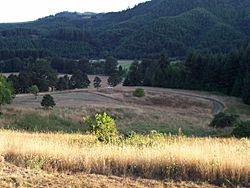Fort Hoskins facts for kids
Quick facts for kids Fort Hoskins |
|
|---|---|
| Benton County, Oregon | |

Grounds of the former Fort Hoskins
|
|
| Type | Military base |
| Site information | |
| Controlled by | United States Army |
| Site history | |
| Materials | Wood |
| Events | |
|
Fort Hoskins Site
|
|
| Location | 38150 Ft. Hoskins Road Philomath, Oregon |
| Nearest city | Kings Valley, Oregon |
| Area | 130 ac |
| Built | 1856 |
| Architect | Christopher Columbus Augur |
| NRHP reference No. | 74001672 |
| Added to NRHP | May 1, 1974 |
| Garrison information | |
| Garrison | 4th Regiment of California Infantry |
| Occupants | 2nd Lt.Philip Sheridan, Capt.Christopher C. Augur |
Fort Hoskins was a military post built by the U.S. Army in the mid-1800s. It was one of three posts created to keep an eye on the Coastal Indian Reservation in what was then Oregon Territory. Today, the Fort Hoskins Site is recognized as a special historical place on the National Register of Historic Places. Famous future Civil War generals, Christopher Columbus Augur and Phil Sheridan, were once stationed here.
Contents
Fort Hoskins: A Look Back
Building the Fort
Work on Fort Hoskins started in 1856 near the Luckiamute River. Captain Christopher C. Augur led the construction. The fort was finished in 1857. Lieutenant Philip Sheridan was in charge of the fort's completion. It was named after Lt. Charles Hoskins, who had died in the Mexican–American War. The fort was about 19 miles northwest of Corvallis.
Life at the Fort
Captain Augur was the first commander of Fort Hoskins. He served there from July 1856 to July 1861. He and his family lived in one of the new houses at "Officer's Row." During this time, 2nd Lt. Phil Sheridan helped oversee the fort's construction.
Two soldiers, Royal A. Bensell and William M. Hilleary, kept journals while stationed at the fort during the American Civil War. Their writings describe a lot of boredom and wet weather. However, they give us a good idea of what life was like in the area back then.
Fort's Impact and End
Fort Hoskins played an important role in the history of the area. Some soldiers who came from other states decided to stay in Oregon after leaving the army. Places like Kings Valley are named after these soldiers.
The fort never saw any major battles. However, soldiers did help calm a situation with Native Americans at Yaquina Bay. Fort Hoskins was closed down in 1865 after the Civil War ended.
Exploring the Fort Hoskins Site Today
A Historic Landmark
The area where Fort Hoskins once stood was added to the National Register of Historic Places in 1974. This means it's recognized as an important historical site.
Fort Hoskins Historical Park
In 2002, Benton County opened the site as Fort Hoskins Historical Park. It's a place where people can visit and learn about the fort's past.
In 2012, the house where the fort commander lived was moved back to its original spot. It had been moved to nearby Pedee after the fort closed. In 2015, Benton County provided money to fix up the outside of the house. The Samuel Frantz (Dunn-Frantz) House, which was once the fort's infirmary, is now part of the park.
The Community of Hoskins
The town of Hoskins grew up west of Oregon Route 223. It was named after the old fort. A post office opened there in 1891 and closed in 1965. Hoskins was also a key stop for the Valley and Siletz Railroad. A small community with shops and a tavern grew around the railroad. By 1915, about 150 people lived in Hoskins, and it had its own school.
See also


